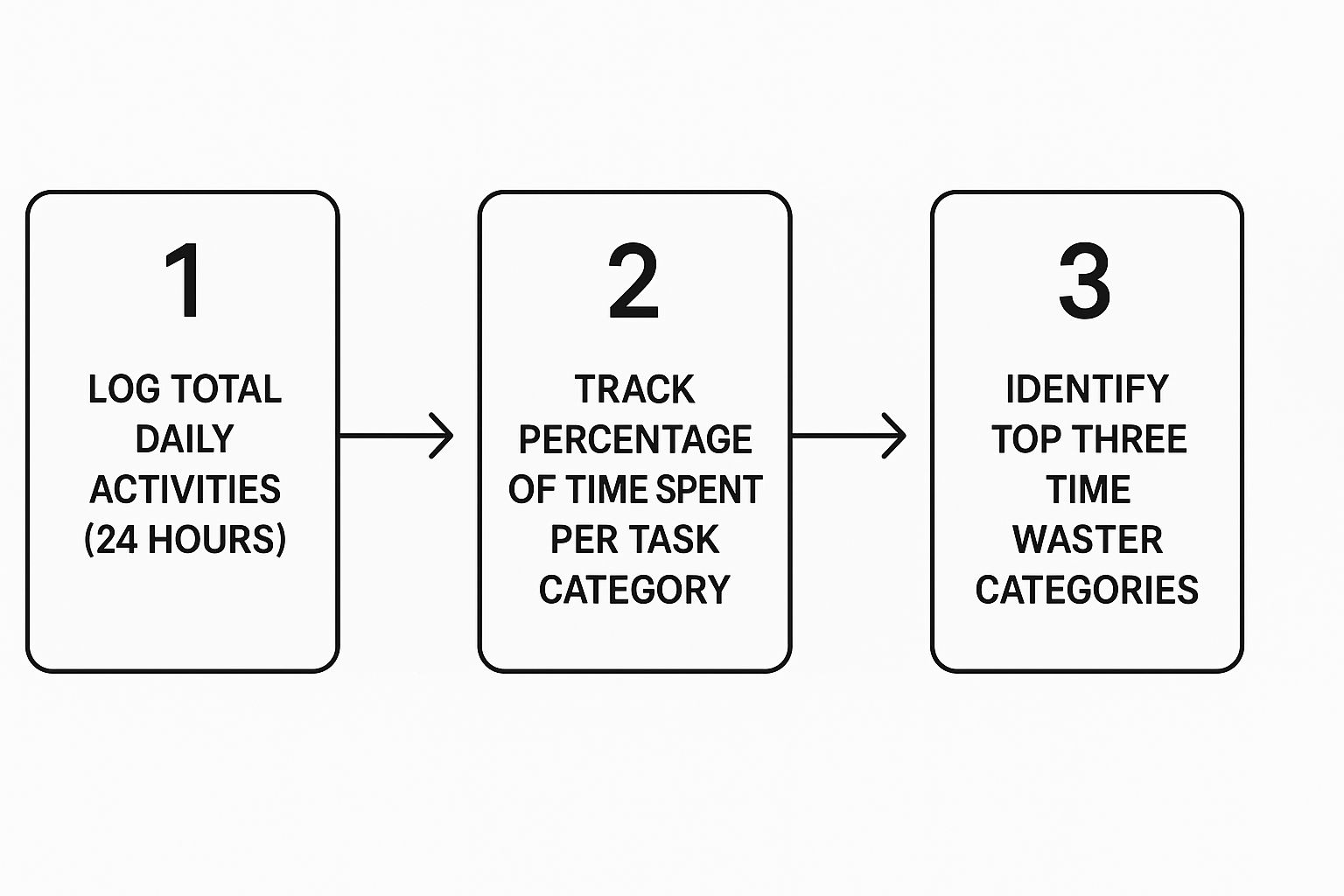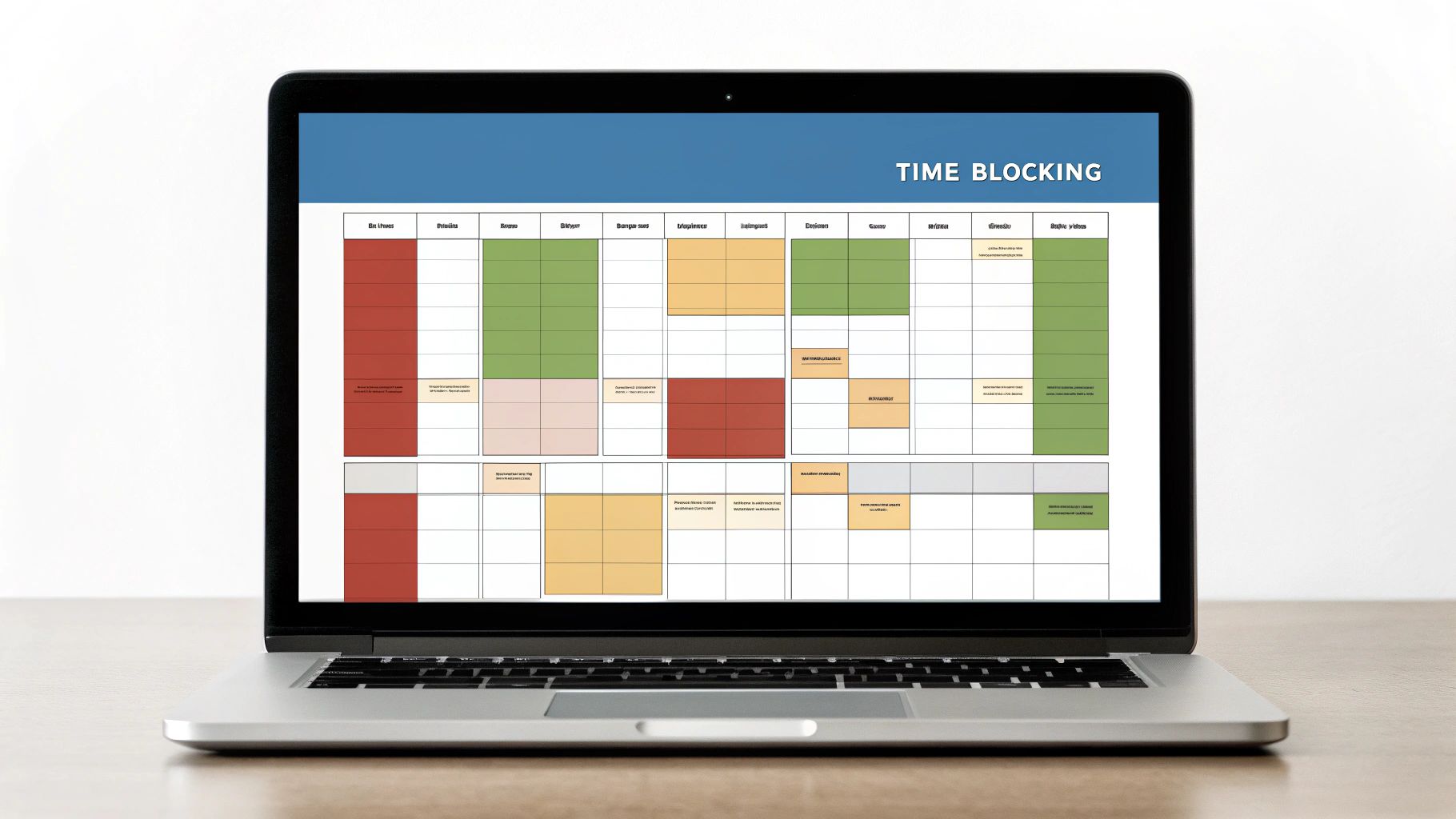
How to Improve Time Management Skills: 10 Expert Strategies
Share
The Real Impact of Time Management on Your Success
We all have the same 24 hours in a day, yet some people accomplish significantly more than others. The key differentiator? Time management. This essential skill impacts not only productivity but also overall success. Think of your time as a financial budget: without a plan, it's easy to overspend and have little to show for it. This section explores the surprising benefits of mastering your schedule and its importance in today's fast-paced world.
The Measurable Advantages of Managing Time Effectively
Effective time management is more than just checking off items on a to-do list. It involves strategically allocating your most valuable resource – your time – to achieve both professional and personal goals.
-
Reduced Stress: Feeling constantly rushed and overwhelmed? Structured time management helps prioritize tasks, reducing the anxiety of approaching deadlines and creating a sense of control. This allows you to focus your energy on execution, not on worrying about what’s next.
-
Improved Focus and Performance: Dedicating specific time blocks to individual tasks minimizes distractions and enhances concentration. This focused approach leads to deeper work and higher-quality output.
-
Increased Productivity: With better focus and less wasted time, you naturally accomplish more in less time. This translates to achieving more goals, whether finishing a project ahead of schedule or finally tackling that personal project you've been putting off.
-
Enhanced Career Advancement: Demonstrating the ability to manage time effectively and consistently deliver results positions you as a valuable asset, opening doors to new opportunities. You might be interested in: How to master...
The Hidden Costs of Poor Time Management
Conversely, poor time management can significantly hinder your progress and overall well-being.
-
Missed Deadlines and Opportunities: Failing to prioritize and manage your time can lead to missed deadlines, potentially damaging your reputation and limiting advancement. It can also mean missing out on opportunities for growth and development.
-
Increased Stress and Burnout: Constantly feeling behind can lead to chronic stress and eventually burnout, impacting both your professional and personal life. Effective time management can often lead to better grades – find helpful tips in How to Improve Grades: Top 10 Tips for Success.
-
Decreased Productivity and Efficiency: Constantly juggling tasks and switching between priorities negatively impacts focus, leading to lower quality work and decreased efficiency. It’s like trying to drive a car with the brakes on – you’ll expend a lot of energy but won’t get very far.
To better understand the impact of poor time management, let's examine a table summarizing the key issues and potential improvements.
The following table demonstrates the significant impact of poor time management on both personal productivity and organizational outcomes.
| Issue | Impact | Potential Improvement with Better Time Management |
|---|---|---|
| Missed Deadlines | Damaged reputation, limited advancement, lost opportunities | Improved project delivery, enhanced career prospects |
| Increased Stress and Burnout | Reduced job satisfaction, health problems, decreased performance | Improved well-being, increased focus and productivity |
| Decreased Productivity and Efficiency | Lower quality work, wasted time and resources, project delays | Streamlined workflows, increased output, improved efficiency |
As you can see, the consequences of poor time management are far-reaching, affecting various aspects of personal and professional life. By implementing effective time management strategies, these negative impacts can be mitigated, leading to significant improvements in productivity, well-being, and overall success.
Adopting proven time management techniques, even in small ways, can significantly boost productivity. While only 1% of workers fully utilize systems like the Eisenhower Matrix, 92% employ elements like to-do lists and scheduling. Companies that implement structured time management frameworks can combat low employee engagement. Gallup reports that 50% of U.S. employees are disengaged, costing businesses $8.8 trillion globally in lost productivity. You can find more detailed statistics here. Mastering your schedule translates into tangible gains, not just in terms of output, but in overall career success and mental well-being.
Uncovering Your Hidden Time Thieves
Before implementing new time management techniques, it's essential to understand where your time actually goes. Like a detective on a case, you need to identify what's stealing your precious hours. This requires an honest self-assessment to reveal the difference between how you think you spend your time and the reality of your daily schedule. This section will guide you through that process, helping you locate your unique time drains and build a foundation for meaningful change.
Tracking Your Time: A Revealing Exercise
Many productivity consultants rely on time tracking as a fundamental tool. By diligently logging your activities for a week, you gain valuable insights into your productivity patterns. This isn't about micromanaging every minute, but about increasing awareness. It's similar to keeping a food diary to understand your eating habits—you might be surprised by the results. You might be interested in: How to master...
-
Identify Time Drains: Do you spend more time on social media or answering emails than you realize? Tracking reveals these hidden time thieves.
-
Recognize Energy Cycles: Are you most productive in the morning or afternoon? Understanding your natural rhythms lets you schedule demanding tasks for peak performance.
-
Uncover Productivity Patterns: Do you work best in short bursts or sustained periods? This knowledge helps structure your day for maximum efficiency.
The Time Audit Process: A Step-by-Step Guide
The following process flow illustrates a simple yet effective process for conducting a time audit. This self-assessment helps you understand your current time management and identify areas for improvement.

The process begins with planning your tracking method, perhaps using a spreadsheet, a dedicated app like Toggl Track, or a simple notebook. Next, track your time diligently for at least a week, categorizing activities as you go. Then, analyze the data, searching for patterns and identifying time-wasting activities. Finally, move into action, developing strategies to eliminate or minimize those time drains. The review and adjust step is vital for long-term success, allowing you to refine your strategies based on continuous assessment. The infographic highlights the sequential steps necessary to conduct a thorough time audit.
To further solidify your understanding of time management, let's examine a practical framework. The table below offers a structured approach to assessing your time management practices.
Time Management Self-Assessment Framework A structured approach to evaluating your current time management practices and identifying areas for improvement
| Assessment Area | Questions to Ask | How to Measure | What Good Looks Like |
|---|---|---|---|
| Planning | Do you plan your day/week? How detailed are your plans? | Track how much time you spend planning and how often you deviate from the plan. | A consistent planning routine (daily or weekly), with realistic goals and allocated time slots for key tasks. |
| Prioritization | How do you prioritize tasks? Do you focus on urgent or important tasks? | Analyze how much time is spent on high-priority vs. low-priority tasks. | Most time allocated to important, high-impact tasks, with a clear system for prioritizing based on importance and urgency. |
| Interruptions | How often are you interrupted? What are the main sources of interruptions? | Log interruptions, noting their source and duration. | Minimized interruptions, with strategies in place to manage distractions and maintain focus. |
| Procrastination | Do you frequently procrastinate? What triggers your procrastination? | Track how often tasks are delayed and the reasons behind the delays. | Infrequent procrastination, with proactive strategies to address procrastination triggers. |
This framework provides a starting point for evaluating your current practices. By honestly answering these questions and measuring your current habits, you can pinpoint areas for improvement and develop tailored strategies for effective time management.
Honest Strategies From the Pros
Learning from those who've mastered their schedules offers invaluable insights. Many professionals stress the importance of honesty about time management weaknesses. This self-awareness is the first step towards real change.
-
Acknowledge Procrastination: Everyone procrastinates. Recognizing this helps you develop strategies to overcome it.
-
Limit Multitasking: Studies show multitasking is less efficient than focusing on one task at a time.
-
Schedule Breaks: Regular breaks are essential for focus and prevent burnout. They aren't a luxury, but a necessity for sustainable productivity.
By identifying your hidden time thieves and understanding your productivity patterns, you're not just adopting generic tips. You're creating a personalized time management strategy based on data and self-awareness, setting the stage for long-term success.
Decision Frameworks That Transform Your To-Do List

The difference between feeling busy and being productive often comes down to effective prioritization. This means making informed choices about how you invest your time, concentrating on tasks that genuinely make a difference. This section explores practical decision-making frameworks that help separate urgent tasks (those demanding immediate attention) from truly important work (that which contributes to long-term goals).
The Eisenhower Matrix: A Powerful Prioritization Tool
The Eisenhower Matrix, also called the Urgent-Important Matrix, is a straightforward yet effective tool for classifying tasks. It helps visualize your to-do list within four distinct quadrants:
- Do First: Urgent and Important (e.g., crises, deadlines, pressing problems)
- Schedule: Important, Not Urgent (e.g., planning, relationship building, preventative measures)
- Delegate: Urgent, Not Important (e.g., interruptions, some meetings, some emails)
- Eliminate: Not Urgent, Not Important (e.g., time-wasting activities, trivial tasks)
Imagine a fast-approaching project deadline—this is both urgent and important, placing it firmly in the "Do First" category. On the other hand, scrolling through social media, while perhaps tempting in the moment, rarely contributes to long-term objectives and should be eliminated. This visualization clarifies where your focus should be.
Value-Based Prioritization and the ABCDE Method
Beyond the Eisenhower Matrix, other frameworks offer valuable insights. Value-based prioritization emphasizes aligning tasks with your overall goals. Ask yourself: "Does this task directly support my most important objectives?" If the answer is no, its priority should be reevaluated.
The ABCDE method offers a structured approach to prioritizing within your to-do list. Assign each task a letter from A (highest priority) to E (lowest priority). This method encourages deliberate decisions about the relative importance of each item.
By systematically categorizing tasks using these urgent/important quadrants, teams can significantly reduce time spent on less important activities. For instance, effective delegation can free up 20% of work hours, allowing employees to focus on high-value responsibilities instead of routine tasks. Learn more about this at Flowlu. This shift promotes more strategic time allocation and boosts overall productivity.
Adapting Frameworks to Your Work Challenges
Successful time management isn't about rigidly following a single framework, but adapting these principles to your specific needs. A sales professional might prioritize client meetings (Do First) while scheduling follow-ups (Schedule) and delegating administrative duties (Delegate). A student, however, might prioritize studying for an exam (Do First) while scheduling research for a long-term project (Schedule) and eliminating distractions like social media (Eliminate).
These frameworks provide a system for making impactful decisions about how you spend your time. Instead of constantly reacting to what feels most urgent, you can proactively dedicate your time to activities that genuinely matter, aligning your actions with your overall objectives. This fosters a shift from reactive to proactive time management. The next section explores how strategic time blocking builds on this foundation, providing even greater control over your schedule.
Strategic Time Blocking: Beyond Basic Scheduling

Time blocking elevates basic scheduling, reshaping how you organize your day. It's not simply about listing tasks; it's about assigning specific time slots to each, creating a structured yet adaptable framework for your hours. This section explores the nuances of time blocking, examining techniques that work with your natural rhythms and boost your productivity. You'll discover how to protect these valuable time blocks from interruptions, resulting in more focused, efficient work. Check out our guide on How to master....
Task Batching: Minimizing Context Switching
A core component of time blocking is task batching. This involves grouping similar tasks and allocating specific time blocks for their completion. For instance, instead of answering emails sporadically, dedicate a specific hour solely to email management.
This minimizes the mental burden of constantly switching between different types of work, a known productivity drain. By concentrating on one type of task at a time, you enter a state of flow, improving concentration and efficiency.
Energy-Based Scheduling: Leveraging Peak Performance
Energy-based scheduling is another effective technique. This involves aligning your most demanding tasks with your peak energy periods. Are you most productive in the morning? Then schedule your most challenging work for the early hours when your focus is sharpest.
If you tend to experience an afternoon slump, reserve that time for less demanding activities like routine emails or meetings. This approach acknowledges that productivity fluctuates throughout the day and capitalizes on your natural rhythms for maximum output. Understanding your energy levels cultivates a more sustainable and productive work style.
Protecting Your Time Blocks: Managing Interruptions
Once your time blocks are established, safeguarding them is crucial. External interruptions, like meetings or unexpected requests, can disrupt even the most well-planned schedules. Communicating your schedule to colleagues and establishing clear boundaries is essential.
Internal distractions, such as the urge to check social media, can also erode your focus. Techniques like disabling notifications and using website blockers can help maintain concentration during designated work periods. This conscious effort to minimize interruptions transforms your time blocks into productive sanctuaries.
Time Blocking in Collaborative Environments
Using time blocking in collaborative environments presents distinct challenges. Open communication, however, is key. Inform your team about your focused work blocks, explaining that you'll be minimizing distractions to maximize productivity during these times.
Suggest alternative times for meetings or discussions, demonstrating respect for your schedule and the team's needs. This proactive communication fosters mutual respect and ensures your time blocks are both effective and considerate. Demonstrating the benefits of structured approaches, compressed workweeks reveal improvements in time management at scale. A 2024 Work in America survey found that 81% of U.S. employees reported increased happiness and maintained efficiency with shorter weeks. This addresses flexibility concerns, considering 33% of surveyed workers lacked adaptable schedules, impacting work-life balance. More detailed statistics can be found here: https://clockify.me/time-management-statistics. These findings indicate a growing trend towards more flexible work structures that support employee well-being and enhanced time management.
By implementing these strategies, you'll progress beyond basic scheduling and develop a more robust, personalized approach to improving time management skills. This provides greater control over your workday, leading to increased productivity and reduced stress.
The Art of Strategic Delegation and Boundary Setting

For many professionals, the biggest obstacle to effective time management isn't disorganization. It's the inability to delegate tasks or decline new commitments. This section explores the psychological barriers that prevent us from letting go and offers practical strategies for overcoming them. We'll examine how strategic delegation and boundary setting are crucial for reclaiming your time and focusing on high-value work.
Overcoming the Delegation Dilemma
Many people struggle with delegation due to perfectionism, fearing that no one else can complete a task to their standards. Others feel a sense of responsibility, believing they should handle everything themselves. However, this mindset often leads to burnout and prevents focus on tasks requiring unique expertise.
Think of a chef washing dishes instead of creating culinary masterpieces. It's a misuse of valuable skills and time. Recognizing these psychological barriers is the first step towards effective delegation. For further insight, explore resources like this: How to master...
A Framework for Effective Delegation
Delegation is more than just handing off a task; it's a strategic process. Begin by identifying tasks that can be delegated without compromising quality. Then, select the right person for the job, considering their skills and experience.
Finally, clearly communicate your expectations. Provide necessary resources and set deadlines. This includes outlining not just what needs to be done, but how you envision it being accomplished. This clarity empowers others to succeed while minimizing the need for constant supervision.
The Power of Saying No
Saying no is another essential time management skill. Many fear damaging relationships by declining requests. However, the alternative – constantly overcommitting – leads to stress and diminished performance. This is especially important in our connected world, where demands on our time can easily escalate.
Saying no doesn't mean you're uncooperative. It means protecting your priorities and ensuring you can deliver on existing commitments. It's a crucial act of self-preservation.
Saying No With Grace
There are ways to decline requests professionally and maintain positive relationships. Instead of a blunt "no," offer alternative solutions or suggest someone else better suited for the task.
For example, try phrases like, "I'm unable to take this on right now, but I can offer some resources that might be helpful." Or, "While I appreciate the offer, I'm currently focused on a project with a tight deadline. Perhaps [colleague's name] might be available." These alternatives acknowledge the request while setting clear boundaries.
By mastering the art of delegation and boundary setting, you gain control of your time. This allows you to focus on activities that truly contribute to your success. These aren't just time-saving techniques; they are essential skills for maximizing your impact and achieving your goals.
Creating a Cohesive Digital Productivity System
Technology offers incredible potential for boosting productivity, but it can also become a major distraction. This section explores how to build a digital productivity system that truly enhances your efficiency. The focus here isn't on chasing the newest app, but rather on strategically selecting and integrating tools that meet your specific needs.
Evaluating Productivity Tools: Choosing What Works for You
Building a successful digital system isn't about using the most apps; it's about choosing the right tools. Start by honestly assessing your current workflow. Where are your biggest challenges? Are you struggling with task management, scheduling, or communication?
Once you’ve pinpointed your pain points, research tools designed to address those specific issues. For example, if deadlines are a constant struggle, a task manager with robust reminder features could be invaluable. If team collaboration is a challenge, explore project management software designed to facilitate clear communication.
Building Your Digital Ecosystem: Integrating Key Components
Many successful professionals use a combination of digital tools working together seamlessly. This might include a task manager for organizing to-dos, a calendar system like Google Calendar for scheduling, and a focus application for minimizing distractions. The Boss Personal Planner offers a comprehensive solution that integrates task management, scheduling, and long-term project planning.
The real power comes from integration. Your chosen tools should connect and communicate with each other. For example, syncing your task manager with your calendar provides a visual overview of deadlines and helps you allocate time effectively. This interconnected approach creates a unified system where all your tools work in harmony.
Taming Digital Distractions: Managing Notifications and Email
Even with the best tools, digital distractions can quickly derail your focus. Notification management is crucial. Disable non-essential notifications and set specific times for checking email and social media. This minimizes interruptions and allows for deeper concentration on prioritized tasks.
Think of your attention as a valuable resource. Every notification diverts your attention, disrupting your flow. Minimizing these interruptions allows you to focus on what truly matters. Digital batching is a great strategy for managing email overload. Instead of constantly checking your inbox, set aside specific time blocks for processing emails, perhaps twice a day.
Automation and Digital Decluttering: Streamlining Your Workflow
Technology offers powerful automation capabilities that can free up significant time. Identify repetitive tasks, such as data entry or social media posting, and explore automation tools to streamline these processes. This allows you to focus on more strategic work.
Digital clutter, such as an overflowing inbox or disorganized files, can also hinder productivity. Regularly declutter your digital workspace by deleting unnecessary files and organizing important documents into accessible folders. This creates a sense of order and reduces the mental burden of searching for information. The goal isn't to collect the most apps, but to create a streamlined digital ecosystem that strengthens your time management skills. By choosing your tools intentionally and managing digital distractions effectively, you can harness the power of technology to achieve your goals without feeling overwhelmed.
Building Resilient Time Management Habits That Last
Mastering time management isn't a quick fix; it's about building sustainable habits that adapt to your life's changes. This section explores the practical, long-term challenges of maintaining productivity, offering strategies to manage interruptions, procrastination, and burnout. Ultimately, the goal is to develop a flexible system that grows with you, delivering results even when circumstances shift.
Handling Interruptions: Staying on Track
Interruptions are a part of life. Instead of letting them derail your schedule, view them as opportunities to practice flexibility. One effective strategy is creating a "buffer zone" in your daily schedule. This reserved time allows you to handle unexpected tasks without impacting your core work. Think of it as a safety net, providing flexibility and preventing minor setbacks from becoming major disruptions.
Another approach is categorizing interruptions based on urgency and importance. Similar to the Eisenhower Matrix, determine if an interruption needs immediate action or can be scheduled for later. This prevents reactive responses and protects focused time.
Managing Procrastination: Beyond Willpower
Procrastination is often linked to environmental and psychological factors, not just willpower. Designing your workspace to minimize distractions is crucial. This could involve silencing notifications, using website blockers, or creating a dedicated work area free from interruptions. This intentional environment removes temptations and promotes deeper focus.
Understanding your procrastination triggers is also key. Do you postpone complex tasks? Break them down into smaller, manageable steps. This makes projects less daunting and easier to start. You might be interested in: How to master...
Reviewing and Refining: Continuous Improvement
Regular review of your time management practices is essential. Schedule a weekly or monthly review to reflect on successes and identify areas for improvement. This is about making incremental adjustments that compound over time, not self-criticism.
For example, if you struggle to complete tasks within allocated time, re-evaluate the time allotted. You might need to adjust the duration or group similar tasks for efficiency. This ensures your system stays aligned with your evolving needs and priorities.
Adapting to High-Pressure Periods: Maintaining Core Principles
During busy periods, it's easy to abandon time management principles. However, this can increase stress and decrease efficiency. Adapt your system while maintaining core principles instead.
For example, during a demanding project, shorten your time blocks while still prioritizing tasks by importance. This maintains structure even under pressure. The Economist noted unproductive meeting hours decreased from 82 to 78 annually since 2020. These gains compound; employees working fewer days often optimize task batching and minimize context-switching, which 43% of workers cite as a cause of exhaustion. Implementing focused work blocks alongside schedule reforms could further enhance productivity. Find more statistics here.
Preventing Burnout: Protecting Your Time and Energy
Effective time management involves protecting your well-being. Setting boundaries between work and personal life is crucial. This might involve establishing specific work hours, limiting after-hours communication, and scheduling regular downtime.
Managing your cognitive load is equally important. Avoid multitasking and prioritize strategically to prevent mental fatigue. Regular breaks and mindfulness practices can improve focus and reduce stress. These strategies are about creating a sustainable work style that supports long-term success.
By addressing these common obstacles and implementing these strategies, you'll develop a personalized approach to time management that evolves with you, delivering consistent results even in changing environments.
The Boss Personal Planner helps you build and maintain these resilient habits. With its tools for goal setting, task management, and schedule organization, you can create a system that works for you, turning chaotic schedules into structured success. Learn more about the Boss Personal Planner and start mastering your time today!
